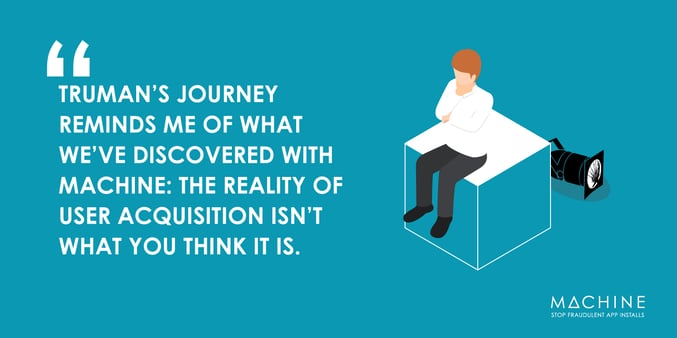
Have you heard the tale of Truman Burbank? He’s living life happily on California’s sunny Seahaven Island – until a studio light falls from the sky.
That’s when Truman starts questioning things: thinking about what he can trust and what he can’t. He discovers he’s the star of The Truman Show – a reality TV show based in an artificial world he’s lived in since birth.
Truman’s journey reminds me of what we’ve discovered with Machine: the reality of user acquisition isn’t what you think it is. Like Truman, we started by picking at a few anomalies and ended up in a very different world.
What’s your user acquisition data based on?
App companies get their user acquisition metrics from a host of sources such as BI Tools, DSPs, attribution platforms, self-attribution platforms (Facebook & Google) and use them to analyse campaign performance, work out ROI, and make decisions about how to spend their marketing budgets.

There’s only one problem: these figures aren’t always the most accurate depiction of reality.
When we started digging, we found so much more fraud than we’d expected. Impressions. Clicks. Installs. The figures were inflated with fakes, and you just couldn’t tell. Businesses were throwing money at suppliers that would never give them genuine results.
That’s a big problem for brands: they’re using these numbers to make important spending decisions - and often wasting huge amounts of marketing budgets. With the size and value of the user acquisition market, it’s a huge problem.
See reality as it really is
So how do you get real numbers that see past the fraud? It comes down to getting better data and getting more data.
You need to look at every relevant data point you can get your hands on – just like Truman when he started to see things that didn’t fit. We look at five main types of data, collating and analysing them to ask three questions: Is the user a real person? Is the device what it claims to be? Is it in the right location?
We’ll ask these questions at five different parts of the user acquisition process:
- Pre-bid – does your bid request data support subsequent event evidence?
- Impression – is it a human, viewable impression?
- Click – is it a real click, or a fake one?
- Install data – does the app download properly, and is it opened by a person?
- Post-install data – how often does the user return, and does it look like genuine user behaviour?
We also use broader datasets than the attribution platforms have access to, so we can find patterns that wouldn’t be obvious in a smaller sample.
With traditional analytics, you might see an iPhone 11 with a UK IP address using Vodafone. With enough extra data points, you can pick it out as a human install farm in south east Asia. Once you start running these checks and comparing them across all your installs, you can build up a clear and genuine picture of your genuine user base and your fraudulent user base.
Why choose an unreal reality?
It can be a bitter pill to swallow. Like Truman, we didn't expect as much fraud as we found. And because brands are spending so much money on user acquisition, there’s a strong incentive for bad actors to keep pushing fraudulent installs... Some businesses even choose to ignore it, preferring to stay with the numbers they know and feel safe on Seahaven Island.
But seeing through to the underlying reality means better decisions – and huge savings on user acquisition. Each dollar you spend will get you better results. You can choose better networks. Better targeting. Genuine results.
As Truman might put it, it’s your chance to say ‘Good afternoon, good evening and good night’ to user acquisition fraud.



